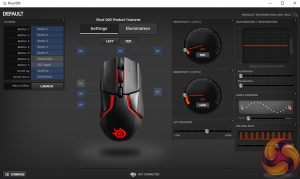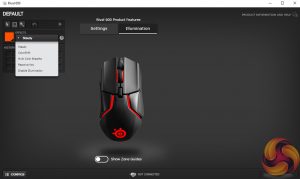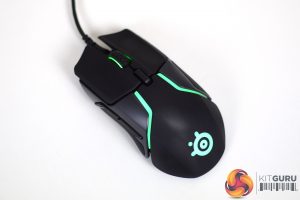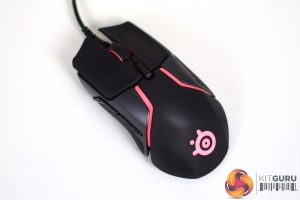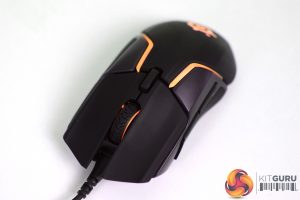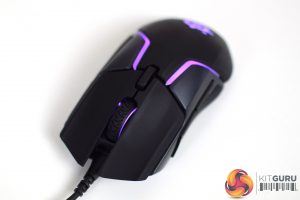Software
The Rival 600 uses SteelSeries Engine 3, the same software we've seen before with the likes of the Rival 700 and 310.
It's very simply laid-out, with just two main tabs – one for adjusting performance settings like LOD, angle snapping and acceleration, and another tab for the lighting. I really like this approach, everything is easily accessible but you still get control over all the key areas of the mouse.
Lighting
The Rival 600 sports a grand total of 8 RGB zones – the scroll wheel, the SteelSeries logo, and then three zones per each RGB strip. The overall effect is certainly impressive for those who are into their RGB lighting. There are various effects to choose from in the software, including colour shift and reactive. You can't go to town creating new effects – Razer mice are best for that kind of thing – but the LEDs come through clear and strong with the Rival 600.
Day-to-day usage
Getting to the main part of our review, I'll start with the overall build quality and design of the Rival 600. While it exhibited no rattling sounds when shook, nor did it feel particularly flimsy in hand, I have three significant issues with the overall design and build of the mouse.
The first is the fact that the Rival 600 is not balanced – it is noticeably bottom-heavy. Using the mouse with my preferred claw grip, I put a fair bit of pressure on the base of the mouse with the bottom of my palm. This caused the front of the Rival 600 to lift up off the mouse mat, which was obviously very frustrating.
I can appreciate that adding some of the included weights would've fixed this issue. However, at 96g the Rival 600 is already a touch heavier than I would like, and adding another 8g isn't going to help. I feel the Rival 600 should be balanced in the first place – users shouldn't be forced to use the weights system just to get a balanced mouse.
The second issue I had – which it would seem is very common – is to do with the primary buttons. My sample's LMB button worked perfectly – it was snappy, quite fast and felt great. The RMB, however, felt so mushy in comparison, it was not pleasant to use at all. Gamers who frequently use the RMB are likely to find its lack of tactility very off-putting.
Lastly, the DPI buttons is simply too tall. It protrudes from the main body of the mouse quite a ways, and in practice this meant I was accidentally clicking the DPI button when I was really trying to click in the scroll wheel. It's things like this which just make no sense to me – the low-profile button on the Rival 310, for instance, is absolutely fine. To my eyes, there was absolutely no need for SteelSeries to change the design of the DPI button and make it awkward to use.
Apart from that, the mouse is fairly comfortable to hold. It's a medium-large ergonomic design, and while I prefer the Rival 310 shape, I can see the Rival 600 proving comfortable for palm and claw grip users.
One last thing to mention is that the detachable cable uses a keyed microUSB connector which slots into the front of the mouse. The cable measures 2m long and is of high quality – I had no issues with it dragging or getting in the way. Being detachable simply makes it easier to replace should it break.
Moving onto performance now, the TrueMove 3+ sensor(s) is a very capable unit. We first saw the TrueMove 3 implemented within the Rival 310/Sensei 310 and it is essentially a modified PMW 3360. The TrueMove 3+ is the same thing, but now with a secondary sensor dedicated to LOD.
Immediately, this presents itself in the software where users can choose between 8 different LOD settings, which adjust LOD between 0.5-2mm. At the lowest setting, the Rival 600 actually stopped tracking on some areas of my mouse mat, so I left LOD at the default, middle setting. At its maximum value, the sensor stopped tracking with two DVDs wedged under the mouse.
In terms of the rest of the optical sensor, performance is as perfect as you'd expect from a modified 3360. I experienced no unwanted acceleration, smoothing or angle snapping, and tracking pixel by pixel was smooth and precise. The sensor as a whole behaved flawlessly.
Elsewhere, aside from the mouse as a whole being imbalanced, the additional weight system works well. Being able to add up to 32g to the 96g base weight definitely broadens the appeal of the mouse – as we found recently, the 90-110g weight range is the most popular among KitGuru readers. For me, though, I just can't get over the simple issue that the mouse isn't balanced by default.
Lastly, the scroll wheel is a high-quality unit, with distinct steps and a lovely textured rubber grip area. It's also relatively easy to click in which can't be said for all mice. The side buttons are also quite crisp and satisfying to press. I couldn't reach the furthest-forward button, but this is disabled by default and I didn't miss it while gaming.
 KitGuru KitGuru.net – Tech News | Hardware News | Hardware Reviews | IOS | Mobile | Gaming | Graphics Cards
KitGuru KitGuru.net – Tech News | Hardware News | Hardware Reviews | IOS | Mobile | Gaming | Graphics Cards


